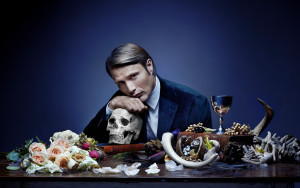I’ve lost count of how many times I’ve seen The Silence of the Lambs, the film that earned Hannibal Lecter his place in pop culture. I saw it in the theater once then at home perhaps a dozen times with my ex-wife. After you’ve seen Silence… a few times, deadened your fear and revulsion responses through a knowledge of what’s to come, you can (or, at least, we did) watch it as the blackest of black comedies. The lines of dialogue are that memorable:
“A census taker once tried to test me. I ate his liver with some fava beans and a nice chianti.”
“Well, Clarice – have the lambs stopped screaming?”
“You know what you look like to me, with your good bag and your cheap shoes? You look like a rube. A well scrubbed, hustling rube with a little taste.”
“You fly back to school, now, little Starling. Fly, fly, fly…”
As anyone who’s seen the movie more than once knows, this is only the beginning of Lecter’s Familiar Quotations. I have a good friend who actually watches Silence… with her husband and kids, the entire family reciting the most memorable lines as they come. Of course it’s a little creepy. Or is it a little funny? Both, I think. Maybe the expectation and enunciation make the darkness easier to take. I don’t know. Whatever the reason, the infectious, memorable nature of so many lines of dialogue from Silence… speaks not only to the power of the film itself, but to Hannibal Lecter’s strength as a dramatic construct. Yes, other characters in the film are memorable (Jodie Foster’s Clarice Starling most of all), but Lecter is the glue (more likely, he’d prefer “marrow”) holding things together.
I’ve watched the other, lesser Lecter movies—Red Dragon, Hannibal, and Hannibal Rising—seen them several times apiece. I actually read all three books just they were released as films. The character of Hannibal Lecter does fascinate me. Funny, though, I’d never gotten around to the TV show. Until now.
Several days ago I began watching Hannibal Season 1, running through its thirteen episodes at a clip of several a day. Season 2 (an additional thirteen eps) followed directly. I came to a halt at beginning of Season 3, unwilling to spring for the additional $1.99 (x 13) Amazon Prime was hoping to extract. Don’t get me wrong. The show is good, very good. But I know it’s been cancelled, Season 3 its last. I’m guessing there’s a reason why. Even if there’s not (beyond falling ratings), I’m low enough on scratch to wait. More than that, I’m tired. Psychically, spiritually, psychiatrically…God, even visually. Hannibal may be good, but it also takes a lot out of you. There’s no other way to say it.
As intellectually enticing as Hannibal is with all its mind games and moral dilemmas, as viscerally so with Hannibal’s (non-cannibalistic) culinary adventures and the concomitant food porn, the onslaught of evil (or deviance, or madness, or all of the above) grinds you down. There’s an extreme weight to the show, a denseness, not only in character development, but in the parade of monsters and victims its lesser players are. Serial killer after serial killer is trotted out for Will Graham (a pure empath, Lecter’s ultimate nemesis) to commune with and catch, Graham growing ever closer to madness himself as he comes to realize his friend, mentor, and pseudo-therapist Dr. Lecter is way more than he seems.
And all along Lecter takes on an identity that borders on the inexplicable, the supernatural. There’s an air of magic in Hannibal, of powers of the mind (suggestion and intuition, mesmerism and outright manipulation) that can’t quite be explained. Thoroughly contemporary as Hannibal Lecter is, a product of our post-postmodern age and all that, he bears more than a few similarities (his powers of persuasion for starters) to one of the greatest literary villains of the Western canon, Count Dracula.
At this point, more than a century since Bram Stoker resurrected the Count’s history and turned it into contemporary fiction, Dracula has held our interest in novel after novel and film after film. Often, the Count and his supporting cast transcend and/or substantially deviate from the basic tale of vampires, castles, and Old World superstition crashing into what then seemed the very apex of science and learning, Victorian England.
Dracula’s been shot into space. He’s been transplanted to modern-day Manhattan. He often goes without his nemeses Harker and Van Helsing. He’s been arch-enemy of the vampiric superhero Blade and a figure of comedy. Dracula is a cultural marker so potent that his key trait, vampirism, has spawned many a scenario in which the Count isn’t even involved (True Blood anyone?).
This malleability of conceit seems to me one of the hallmarks of real cultural impact, of staying power. An attribute that’s echoed in the way Hannibal is able to recast the basic Lecter story Thomas Harris has penned in his novels, to update it several decades but also to make it more granular and, at times, even deviate substantially from Harris’s texts. Television’s Hannibal is a thing its own, a creature born of the Harris books, but not one with them.
If a story or a character can survive decades of increasingly diverse interpretations, you know you have something. Think about Shakespeare’s work as an example. Shakespeare’s power in our culture is akin to, perhaps in some ways even beyond, that of classical mythology at this point—we get the allusions instantly but we can also see deviations from the standard and accept them. The core stories (Hamlet, Macbeth, Romeo and Juliet, Othello, etc.) are strong enough for us, vividly enough coded into our collective conscious that we can stand and even enjoy their transformations. This isn’t always the case. Think, for example, of another piece of art that dominates contemporary imagination, George R.R. Martin’s A Song of Ice and Fire.
Two decades, five books, and five seasons of Game of Thrones, the series it spawned, and the cracks are beginning to show. Sure, the Nielsen ratings are still high. But Martin’s inability to complete the last two books in his cycle has resulted in a fairly significant divergence in story lines between the book and television versions, a fact that has caused consternation to a few fans, this one included. The trouble Martin and HBO are encountering right now is lack of a canonical story, the sort of backbone that would allow for deviations. Does this have to do simply with timing, is it just that scheduling has “fouled things up”? Maybe, but probably not. Now—and certainly if the trend continues with future seasons (and books)—there will always be doubt about what’s real in this world, about what its core realities are. More than that, the doubt exists at the world’s genesis, which may to some extent mute the overall impact of Martin’s work. Obviously, this can be fixed. And, for an extended narrative still in process, you can’t set the same standards as you would for a story that’s run its course. What this does point to is why Hannibal Lecter is such a powerful cultural icon, how he may at some point in the not too distant future begin to seem emblematic of his age in the same way Stoker’s Dracula is of his.
The connection between Lecter and Dracula isn’t a new one. The Count and the Doctor have more than a few similarities. There are the consumption of human beings as food, the inexplicable mental powers of persuasion I mentioned earlier, and devilish brilliance. Writing for The New York Times all the way back in 1999, Stephen King noted, “If Hannibal Lecter isn’t a Count Dracula for the computer-and-cell-phone age, then we don’t have one.” A quick Google search will reveal that more than a few people have come to similar conclusions since. Creating linkage between Lecter and Dracula isn’t what this is about, not really.
The singular, superpowerful villain is a deep myth for humanity, an obvious personification of humanity’s overarching opponent or adversary, the unknown. In the West, the most obvious example is Satan, a creature of Christian mythology that far predates Hannibal Lecter or even Dracula. And there are certainly many grand, cosmic villains that predate Satan. It’s not much of a stretch to think that the earliest notions of magic, myth, and religion countenanced the personification of the inexplicable as symbols of good and evil. One of the easiest things to do for humanity—as easy as worshipping natural forces or animals—is to worship itself, an aspect or construct at least that resembles itself. To what end do we keep anthropomorphizing evil, though? This is one of the key questions my Hannibal binge had me asking. There were others, of course.
I wondered about the existence and traits of God, something Hannibal himself muses on freely, hinting more than once that he might as well be God. And maybe he is in a sense, the point being there’s no God at all or, worse still that God is like Hannibal Lecter. I also thought a lot about the duality of sanity and madness and whether that’s as tenuous and imprecise a paradigm as that of good to evil. I wondered, whether the good brain versus bad brain construct is just another of humanity’s failed guestimates about how to explain the inexplicable. In the end the conclusion I drew was a basic one, more grounded in simple criticism than grand revelation. These questions point to why the story of Hannibal Lecter is so potent for us, why it stands up to retelling and reinterpretation as it does in TV’s Hannibal.
The dangers of madness and evil—their seductiveness, at least in fiction—are obvious. For the writer and reader, the fictional space is a transactional one, a space in which a piece of art can be exchanged in a sense; where artist can plumb the depths of societal, personal, and even imaginary darkness, where the audience member (in whatever medium) can do all these things for themselves, without the work or psychic danger of creative immersion.
The audience member can create space when she needs to, can end exposure, much more easily and readily than the art’s maker. Though, let’s be clear: never entirely. There exists the possibility—more than that, the certainty on some level—that audience member will have to contend with the impact of viewing the fictional evil or insanity (the unknowable as we’ve come to refer to them). It’s just that they do it at a greater distance and separate from it with greater ease than the artist.
Hannibal is a sticky piece of art, one that resists such separation. It haunts you in a way, crowds out lighter thoughts with far weightier ones. This is dangerous even for a writer, an artist of sorts, such as me. Leveraging off of Dracula and beyond that some of our seminal doubts as humans, Hannibal Lecter is a villain for the ages. And this TV series proves his…chops…yet again.
In the depths of his evil or insanity, both, or perhaps even more terrifyingly, neither, he plays on our darkest fears as a species. The reality that even we ourselves are ultimately unknowable. And as long as that state exists—which will, no doubt, be as long as we do—there will always be a chance, a “ghostly potentia” to quote Martin Amis from his masterpiece London Fields, that evil and insanity are unknowable enough they may exist inside us all; that even these terms on which we base so much of our lives and thoughts may be wholly imprecise, may not yet scratch at the surface of what we are.




